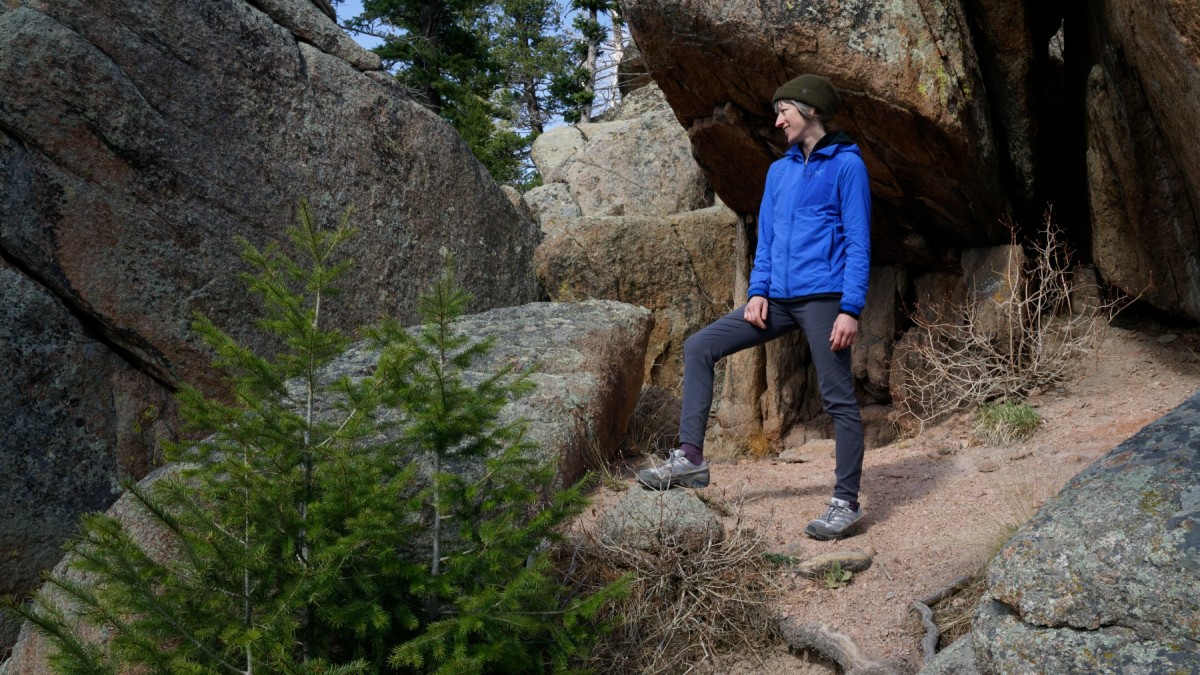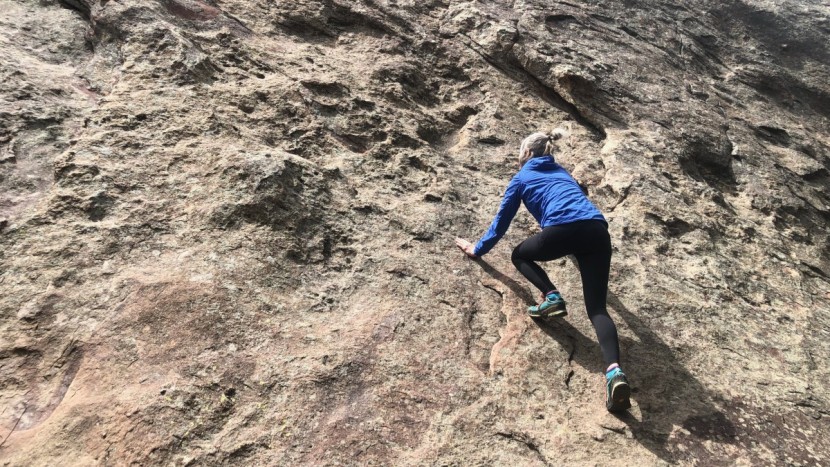Our Verdict
Our Analysis and Test Results
The Arc'teryx Proton FL triangulates between a lightweight insulating layer and a breathable wind layer, proving an exceptional option on windy or chilly mountain days. The fleece lining is soft against bare skin, making this jacket among the coziest we tested, even if there is some slippage between the fleece lining and the sleeve when you put it on over a long-sleeve layer. This plush hybrid is among the lightest-weight, warmest, and most versatile jackets in our review. It is great as an outer layer on warmer climbing days and as an insulating layer for winter backcountry adventures. If you crave more warmth but don't want to sacrifice breathability or mobility, this might be the jacket for you.
Weather Protection
The Proton FL scored decently well in this category because it is fairly wind-resistant and warm. It effectively takes the edge off the wind and the cold, as long as the temps don't drop too low. When it does get too cold, this lightweight jacket is easy to layer under something more substantial.
In our water-resistance tests, the Proton FL performed decently well, but the breathable fabric failed our soak-through test, fully absorbing water within 10 minutes. In the real world, it does resist a little moisture, as long as you are not in a heavy storm. Simply put, this jacket is not an ideal rain layer. Wind resistance is where the Proton FL really shines. It features two panels with proprietary Fortius Air 20 fabric, which offers wind protection while still remaining breathable. The Proton FL proved its merits when tested on windy days of alpine climbing in the Sierras and the Rocky Mountains, keeping our reviewer fairly warm despite strong winds.
Without insulation, the Proton FL would just be a super-thin active softshell. But with plush fleece insulation, it is an active softshell on steroids. It is warm enough to be a fantastic insulating layer while ice-climbing or as a light shell on windy days rock climbing. It is also warm and breathable enough to be a perfect outer layer for summer peak-bagging or alpine rock climbing, where temps can fluctuate wildly in wind or shade. It handles wind and cold like a beast and, when coupled with an ultralight rain jacket, is an unstoppable force for the alpine. Simply stated, we love this jacket.
Breathability
Even though the Proton FL is insulated, it is shockingly breathable. It is basically magic. Brisk uphill hikes have nothing on this jacket. Where most layers would leave you feeling swampy, the inner fleece lining effectively whisks moisture away from the skin, while the Fortius Air 20 fabric allows body heat to escape when your heart rate is high. All this works together to keep you dry while working hard in cooler temps.
When paired with a hard shell or technical softshell for ice climbing, the Proton is fantastic as a breathable insulating layer. It can get balmy on warmer days but is breathable enough to avoid the post-swamp chills. The impressive breathability of this jacket proves suitable for all kinds of mountain athletes, including everyone from mountaineers, backpackers, and backcountry skiers to bicycle commuters, rock climbers of all persuasions, and even ice/mixed climbers.
Mobility
The Proton FL ranked incredibly high in terms of mobility. It feels light and soft on the body, and the articulated elbows and gusseted underarms make any activity accessible and non-restrictive. The newly designed hood is form-fitted but spacious and stretchy enough to allow unimpeded movement even when under a helmet.
The Proton FL offered unhindered mobility on several climbing routes and styles. It proved a worthy companion on all manner of routes — from granite multi-pitching in January, sunny late-winter days in Eldorado Canyon, to approaching ice climbing routes, and as a do-it-all late-winter jacket in Indian Creek. It became our go-to layer for alpine starts in the Black Canyon and alpine rock climbing in the Sierras and Rocky Mountain National Park. There were rarely (if any) instances of hemline-creep or climber's crack. The hood is slim and fitted enough to be worn under a helmet without issue, and the fleece-lined pockets are great for warming hands between routes. All-in-all, the Proton offers unrestricted movement with little exception.
Weight
In a size small, the Proton FL weighs 11 ounces, which is among the lightest jackets in our review.
Compared to the active softshells in our review, the Proton FL may not be the lightest jacket, but its warmth-to-weight ratio is unrivaled. Beyond the sheer numbers, it feels shockingly light on the body. If you want a layer that can cover a lot of bases without weighing you down, this is an excellent candidate.
Versatility
The Proton FL is easily the most versatile jacket in our review. We gauge versatility by considering the features, durability, aesthetic design, and the array of ideal activities/weather conditions for each jacket. Without exception, the Proton met or exceeded expectations for each category. It is feature-rich and user-friendly, ideal for rock and alpine climbing, backpacking, hiking, and bicycle commuting in chilly weather. When paired with another layer, it is great for winter backcountry adventures.
While the Proton FL is not made to be an ideal layer for ice climbing, it could be worn as an outer layer on warmer days or as an insulating layer on colder days. The redesigned hood has a cozy fleece lining and is slightly more spacious, which means you can wear it comfortably with a helmet without compromising mobility. One large chest pocket provides good storage, and the hand pockets are softly lined to provide extra comfort and warmth.
Both the hood and hemline are quick and easy to adjust to create a tight barrier against the elements, and the soft fleece insulation keeps you warm without getting swampy. The cuffs aren't adjustable but are stretchy enough to fit over thin gloves and low-profile enough to slide under gauntlet-style gloves. We are disappointed that this revised version does not have a pocket that doubles as a stuff sack, so you can easily stash your jacket and clip it onto your harness — a design feature we hope to see in future iterations. Additionally, when you pull your arms through the sleeves while wearing a long-sleeved shirt, there is some slippage between the fleece lining and the outer shell material on the sleeves. Otherwise, this is a warm but breathable jacket with premium features that will move well between the seasons and whatever adventures you get into.
Value
As with most things from Arc'teryx, this softshell does not come cheap. However, it is innovative, well-made, comfortable, warm yet breathable, and lightweight. If you want a comprehensive mid-layer that can stand alone or be part of a thoughtful layering system, the Proton FL is worth the hefty price tag. If you just need something simple for occasional use, this is likely overkill, and we'd suggest seeking out a less technical and more affordable model.
Conclusion
Often, hybrids don't function particularly well because they try to do too much at once, but the Arc'teryx Proton FL is the best we've had the pleasure of testing. It is warm without being stifling, lightweight, stretchy while still providing surprisingly good weather protection, and the versatile features make it appropriate for many different kinds of activities. It is reasonably durable and well-tailored, giving it a great aesthetic on and off the rock. Fantastic as an outer layer in warmer temps or a light insulation layer in colder temps, this jacket is an excellent all-arounder for those who have a hard time sticking to one activity or one season in the backcountry.













